Added note, February 2006:
This series of articles deals with the creation of naturally short tailed (bobtail) Boxers as carried out over a series of generations, and attempts to answer breeder questions. The primary objective was to evaluate the difficulties in introducing a gene from one breed into and subsequently re-establish the recipient breed type. This proved to be remarkably easy. Bobtail Boxers have spread around Europe, and to Australia, and have competed successfully in the show ring with both long tailed and docked dogs. However, whether the inherited short tail will replace docking in the event of a total ban on this practice remains to be seen. The disadvantage of the tail gene used is that, as only learned in the course of the investigation, it will not breed true. Ideally, the process should be repeated with a 'better' tail gene.
I have often thought with envy about dog breeding at the turn of the Century. This must have been a truly exciting period. It was a time of construction when older breeds and varieties were melded together to make new and exciting ones, each developed for specific purposes. Today, crossbreeding is no longer a recognised option but for the first 50 or so years of this century, crossbreeding to allow the introduction of new or otherwise desirable characters into established breeds was permitted by the Kennel Club, and this too must have been fascinating. I believe that only three backcrosses were needed before registration was again permissable. Nowadays, however, with K.C. registered dogs, pure breeding is the only option. Crossbreeding for any purpose is not considered, and I'm sure that even the idea may be thought of as heresy by most present-day breeders.
During my 50 or so years in Boxers I have, like everyone else, pretty well accepted the status quo. The challenge has been to produce the top class specimen excelling in type, construction and temperament etc.. But, in Boxers, the need to dock tails has, for me, always been an irritant. Why does one have to cut something off to achieve the required overall appearance. Why, therefore, not develop a Boxer with a naturally short tail - and maybe with erect ears too, if one prefers this image, instead of the cropped ear still largely accepted on the Continent or in American? How easy would it be in any case to introduce a gene from one breed into another?
With such thoughts in mind several years ago, I looked up the literature on short tails and ear carriage to see what might be possible but, finding the evidence sparse and unconvincing, I went no further. However, on coming across a couple of related Boxers with short, screw tails soon afterwards, I was prompted to see if the condition was inherited. I bought the two dogs, one a male from the South West and the other a female from Yorkshire, placed them in pet homes and when they were old enough, mated them together. A healthy litter of seven pups was obtained, but all had full length, normal tails. It therefore seemed unlikely that the condition was inherited; and I was already aware that abnormalities of tail development are fairly common in dogs as I know they are in laboratory mice. This could have been the end of the story, but the tail docking issue that has been emerging in recent years has gradually converted my flights of fancy about inherited short tails in
Boxers into perceived need. And similar thinking by two astute Pembroke Welsh Corgi breeders, Peggy Gamble (Blands) and the late Patsy Hewan (Stormerbanks) led me to look seriously upon what I began to see as a realistic option.
They had asked me to look into the inheritance of a bob-tail condition that exists in a few show lines, notably Patsy Hewan's Stormerbanks. Apparently the condition had been a characteristic of the breed in its early days as a working farm dog. The pedigree data I was given suggested a simple dominant inheritance, with about half the progeny from bob-tail x normal outcross matings showing the effect. Tail length, I was told, varied from almost tailless to about one-third normal and no associated abnormalities had been seen. There were no data from bob-tail x bob-tail matings, which was worrying, because from genetic studies upon similar tail anomalies in mice it might be expected that animals with two doses of the responsible gene might not survive to birth. On the other hand, were the condition one of those described in the scanty dog genetic literature, there was a possibility that the double dose animal might survive, so that the condition might breed true.
This, at least, might fit better with the existence of the gene in working farm dogs. Interestingly, some 50 - 60% of Swedish Vallhunds are born with bob-tails and may carry the same gene. So far as I have been able to discover, there are no associated abnormalities in this breed either, but there appear to be no records which would indicate if the condition might ever breed true. A few other breeds also appear to carry either this bob-tail gene, or perhaps another with similar affect, and different modes of inheritance have been suggested.
It is now a matter of history that Peggy Gamble (jointly with Cliff Whitwell) bought a Stormerbank bitch with a bob-tail, crossed it with a dog of her breeding to establish a bob-tail line. A bob-tail dog, Vaquera of Pemwell, from this first mating was to become the sire of Peggy's first bob-tail champion (made up at Bath 1994, I think). Therefore, could the gene be crossed into the Boxer? Peggy Gamble was willing to help and, for me, the opportunity was too good to miss. It would really be fun to try and breed a Boxer with an inherited short tail. The attempt would also permit evaluation of the difficulties of transferring a single gene from one breed to another, a procedure which might have wider applications someday in the world of dog breeding. And, of more immediate scientific genetic interest, DNA analyses could contribute to the Canine Genome Mapping Project under way both in this country and in the United States. Plans were made for a Boxer x
Pembroke Welsh Corgi cross.
THE CROSS
The first attempt was not successful. I opted to try a last litter from our Steynmere Top Bid, who had been a reasonably successful show bitch in her day. It meant a trip up to Yorkshire one Christmas eve. My wife was not impressed. Biddy, however, thought it all the greatest fun, but despite a good mating, achieved with the help of a series of drawers stacked high to compensate for the height difference and much handling dexterity by Peggy Gamble, no litter resulted. It seemed that I would have to start from scratch with a younger bitch. But I did not want to commit a show bitch to such a cross. The solution was to keep a white one, such as commonly occur in Boxer litters, specifically for the purpose. White Boxers are not usually kept as they do not conform to the Standard of the breed, and they are also at risk of being deaf.
A white bitch was to appear in a 1991 litter by Ch Skelder Singing Sleuth ex our Charivari Amber of Steynmere, a Ch Garnet Gelert of Steynmere daughter. Steynmere Pearl (known as Polly, short for Polyfilla) was not deaf and, apart from her white colour, became a very nice bitch. So, in November 1992, off I trailed to Yorkshire to visit Peggy Gamble and her bob-tail Corgis. Prof Morton, a specialist in artificial insemination at the University of Birmingham was on standby in case of emergency. However, again with Peggy Gamble's expertise, a natural mating to Cliff Whitwell's Vaquera of Pemwell was achieved. In due course we got our litter.
THE GENETIC EXPECTATIONS
A first prediction from crossing of two breeds (Fig. 1) is that, barring the segregation of individual genes in each breed, eg red versus brindle, all the progeny should look alike. But, what else could be expected
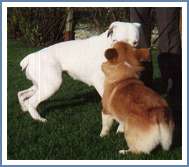 |
|
- Corgis have a fawn colour with the same genetic basis as Boxers, but they differ with regard to several known genes;
- the white markings are caused by a different form of the gene responsible for whites and white markings in Boxers;
- the legs are short (dominant);
- the coat is long relative to that of the Boxer (supposedly dominant);
- the ears are erect (supposedly recessive);
- Corgis do not have the black masking factor (dominant); and finally,
- the Corgi used in the cross had a single dose of the bob-tail gene (dominant).
|
Fig. 1 The introduction; the white Boxer and the Pembroke Welsh Corgi. |
|
The Corgi-Boxer crossbreds were therefore expected not only to be uniform in appearance; they should be fawn, have intermediate near-50:50 levels of white markings (piebald), perhaps show a black mask (dependent upon white markings), have short legs, a longish coat, and drop ears, but the bob-tail gene was expected to segregate such that only half the puppies would have bob-tails. Beyond this, the unique head features of the Boxer might be expected to give way to the more normal Corgi head.
THE LITTER
|
|
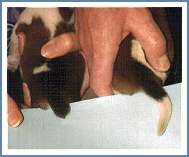
|
Fig. 2 The crossbred litter - all alike with near 50:50 (piebald) levels of white markings. |
|
Fig. 3 Bob-tail and normal tail |
In total, 7 pups were born and all indeed looked alike. They weighed about 14ozs, and all were fawn. Confirming the genetic basis of Boxer and Corgi white markings, they all showed the piebald level of white markings (Fig. 2). Traces of black masks could be seen on some.
But, more importantly, 5 had bob-tails of lengths varying from that of the docked Boxer (Fig.3) to about one-third normal, while the other 2 had tails of normal length. No other anomalies were detected at birth or subsequently. All the expectations were therefore met and the dominant bob-tail inheritance was further established. However, in our eyes the pups looked horrendously ugly, at least at birth. They simply looked like very bad, overmarked Boxers. Initially we did not like them at all.
|
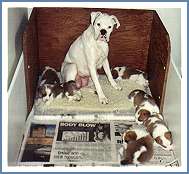 |
By the age of 5-6 weeks things were better. The pups no longer looked like awful Boxers, but rather like an unrelated and somewhat cute breed (Fig. 4). And they all still looked alike. The Corgi overwhelmed. The heads were Corgi-like, the legs were short, the coats were longish and somewhat wavy, the tails of bob-tail pups (and normals) were free from kinks, though tended to bend over the back, but all the pups appeared to have drop ears. Only in eyes, expression and temperament did they resemble Boxers. They looked ideal puppies for little girls, and a photo in the vets' surgery a few weeks later had them selling like hot cakes. The "Borgies", as they were to be known, became famous in the local community and also at my Genetics lab where they were a source of much interest.
We had a Borgy party in our garden when the pups reached 7 months of age. |
Fig. 4 The results -
Polly and her crossbred litter. |
Seen together they all then looked like strong Corgis, but one had erect ears (Fig. 5) which does not accord with the supposedly recessive inheritance of this character. On close inspection of the others, all the ears were found to be stiff, almost cardboard-like to touch, unlike the soft, velvety Boxer ear, and tended to stick out at odd angles. Erect ear carriage would therefore appear to be at least semi-dominant. It seems likely that if the ear is small enough it may stay erect, even with only one dose of the gene.
Two of the bob-tail pups were bitches and these were sold on condition that each would have a litter. Both had 6 month seasons and at 18 months we attempted to mate one of them, named Dolly (Fig. 6),to our Boxer male, Steynmere Foreign Service (Fig. 7).
for Dolly's pedigree click here
|
|
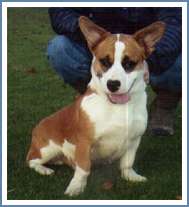 |
Fig. 5 One of the crossbred puppies (seen here as an adult) had erect ears. |
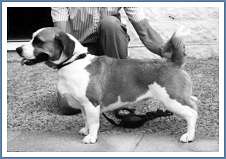 |
|
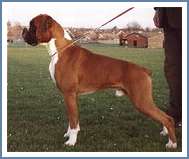 |
Fig. 6 Dolly, one of the two crossbreds used for breeding.
|
Fig. 7 Steynmere Foreign Service, the mate for Dolly and Tess. |
Disaster. While it was love at first sight, the deed seemed impossible. She stood on her tip toes and he stood on his hocks, but to no avail. And attempts to use a platform were foiled by Dolly's refusal to be held by the collar. As a last ditch approach I rushed the pair off for an artificial insemination attempt by the UK expert, Garry England, at Potter's Bar. We were running late in the season by this time, but all went very well. However, no litter resulted. The other bitch, Tess, had come into season only two weeks after Dolly, but we had opted not to mate her. So, another 6 months went by. Then Dolly came into season again.
This time I was determined to get a natural mating and persuaded friend and neighbour, Gordon Seeney of Maranseen Boxers, to shed his principles regarding the whole business and come to help. Dolly was so ready mate, but still refused to be held even loosely by the collar. Sharp dewclaws slashed the back of my hand (a case for their removal if ever there was one), but with heavy duty lifting by Gordon we succeeded in getting a brief mating, if without a tie. The chances of her getting pregnant seemed remote, so when sister Tess came into season on cue two weeks later we opted to take her directly for artificial insemination. And this was done. But, both bitches became pregnant. Dolly had 9 pups and Tess 7, both completing their whelping in about 2 hours, and without any assistance. Moreover, both bitches reared their litters without loss or any intervention until weaning time. Borgy breeding was a doddle. I had 16 pups from which to choose one or more for the next generation.
In Part 2 of this article, the revelations of the backcross will be described..


:Home: :About: :Champion Boxers: :Other dogs of Note: :Photo Gallery: :Bobtail Boxers:
:Bobtail Gallery: :Genetics: :Links:
:Guestbook: :Email:

